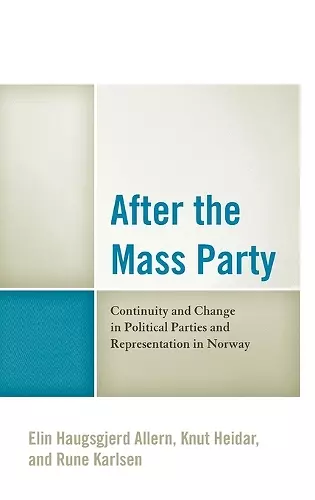After the Mass Party
Continuity and Change in Political Parties and Representation in Norway
Elin Haugsgjerd Allern author Knut Heidar author Rune Karlsen author
Format:Hardback
Publisher:Bloomsbury Publishing PLC
Published:16th Dec '15
Currently unavailable, and unfortunately no date known when it will be back

This book examines whether parties’ ability to channel voter interests into political institutions has in fact declined in the wake of decline of party membership figures and the increase of state finance of parties. It first looks at relevant empirical studies to summarize what we already know. Second, it presents an in-depth study of Norwegian voters and parties, based on a number of voter, member and parliamentarian surveys conducted between 1990 and 2010.
The existing literature is scarce and indecisive, whereas the Norwegian parties still seem to represent voters fairly well, despite the waning of mass parties. The party organizations—the members, activists, and representatives—continue to channel voter opinions into the Parliament. This book argues that the high and persistent policy congruence between voters and parties revealed might be related to party members and mid-level activists still resemble voters socially and politically to a large degree. At the same time, the party competition for votes is also still relatively efficient, and there appears to be some interaction in terms of what happens within party organizations and the stimuli offered by competing parties.
Hence, this book challenges the “decline thesis”. It argues that parties can continue to represent, even “after the mass party”. At the same time, it suggests that the persistence of the formal representative structures and the closed candidate selection processes that you still find in Norway and elsewhere could make some parties somewhat more resistant to representative decline than others.
This ambitious study examines political change in Norway to offer more general lessons on the evolution of representative democracy ‘after the mass party.’ Using an unusually rich trove of longitudinal data on Norwegian voters, MPs, conference delegates, and party members, it thoughtfully investigates how—and whether—party organizational change affects congruence between MPs and those whom they represent. This book’s lively engagement with widely-shared theoretical assumptions, and its careful empirical work, make it recommended reading for everyone with an interest in the evolution of political parties in contemporary parliamentary democracies. -- Susan Scarrow, Department Chair of Political Science, University of Houston
Political parties have not lost their function but are alive and kicking. The membership of political parties has declined but in contrast to what is generally believed their capacity to represent the voters has not. Political parties are as representative as ever. This is the surprising conclusion of this book on the development of political parties and representative democracy in Norway. It is a must read for anyone interested in political parties and representative democracy. -- Jacques Thomassen, University of Twente
ISBN: 9781498516549
Dimensions: 234mm x 160mm x 16mm
Weight: 390g
168 pages